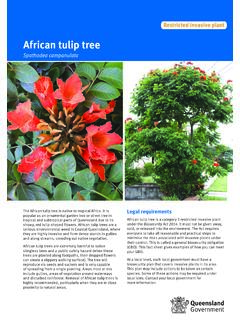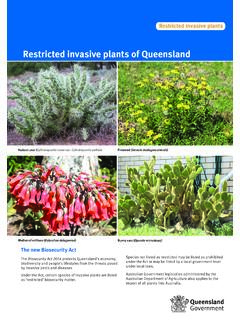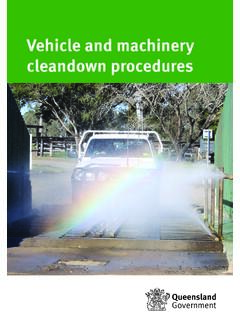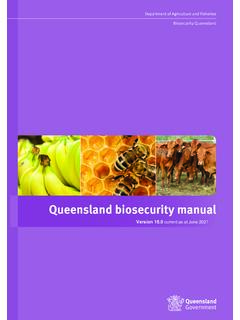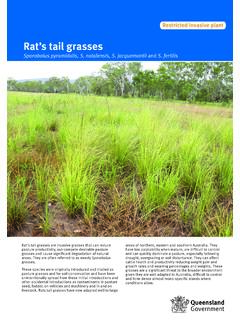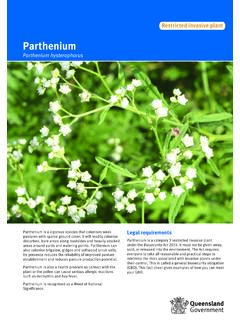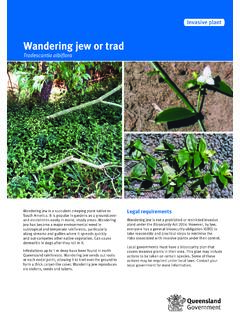Transcription of The prickly pear story - Department of Agriculture and ...
1 Acknowledged as one of the greatest biological invasions of modern times, the introduction and subsequent spread of prickly pear into Queensland and New South Wales had infested millions of hectares of rural land by the 1920s, rendering it useless for Agriculture . prickly pear proved so difficult and costly to control by chemical and mechanical means that enormous areas were simply abandoned by their eventual control of this pest, mainly by one insect and in the space of a few short years, is an amazing story that has encouraged further successful developments in the field of biological pest prickly pear is the general term used to describe over ten members of the Cactaceae family. Most of these cacti are of the opuntia species, which are indigenous to the Americas and are characterised by their fleshy, spine-covered growth.
2 The term prickly pear is derived from the plant s spiny and pear shaped most of its growth cycle prickly pear is a leafless shrub. The flat branches are commonly called leaves but the terms pad or joint are more accurate. The true leaves of the prickly pear plant are small, fleshy scales, usually pointed and commonly red or purplish in colour. The prickly pear story Restricted invasive plantThese leaves are present on young shoots but fall off soon after they appear. Scattered over the pads and fruit are spots called areoles from which spines or bristles grow. Each areole is also a growing point from which a new pad, flower or root can flowers are fairly large and usually yellow but ondifferent species can be white, deep orange, red, pink orpurple. The tough outer skin of the fruit is usually red whenripe but may be purple, orange or of the lack of leaves and the tough outer skin ofthe pads, the plant is very drought-resistant.
3 Some speciesgrow bulbs under the ground and, should the plant abovethe ground be destroyed by bush fire or stock, the bulb willusually survive and give rise to new cacti that have attained pest status in Queenslandinclude: common pest pear (Opuntia stricta var. stricta) spiny pest pear (Opuntia stricta var. dillenii) tiger pear (Opuntia aurantiaca) drooping tree pear (Opuntia monacantha) velvety tree pear (Opuntia tomentosa) westwood pear (Opuntia streptacantha) devil s rope pear (Cylindropuntia imbricata) coral cactus (Cylindropuntia fulgida var. mamillata) snake cactus (Cylindropuntia spinosior) harrisia cactus (Harrisia martinii, and H. pomanensis) Hudson pear (Cylindropuntia pallida and C. tunicata) jumping cholla (Cylindropuntia prolifera) bunny ears (Opunita microdasys and O.)
4 Rufida) cane cactus (Austrocylindropuntia cylindrical) Eve s pin cactus (Austrocylindropuntia subulata).History of introductionThe first recorded introduction of prickly pear was attributed to Governor Phillip at Port Jackson in 1788. It is thought that the shipment comprised drooping tree pear (Opuntia monacantha) and possibly one or two other species. The reason for introducing the plant was to create a cochineal industry in the new colony. Cochineal is an insect that feeds on certain species of cactus and from which a scarlet dye is obtained. This dye was used to colour the distinctive red coats of the British soldiers at that fate of this first prickly pear plantation is not known; however, other introductions of different species followed and evidence suggests that plants were growing in cultivation at Parramatta prior to 1840 and spread to Chinchilla in Queensland by prickly pear is established from either seed (by germination) or plant segments (by vegetative reproduction).
5 The main dispersal method occurs via the tough, coated seeds that pass undamaged through the digestive system of animals and birds. The heavy crop of fruit produced by pear plants is particularly palatable to birds such as crows, emus and magpies. Many new infestations probably occurred through the germination of seed in bird segments are easily detached from the parent plant by animals, wind or flood waters, and take root where they lodge. It is believed that the flood of 1893 spread seed and plant parts to many new pear infestations covered 10 million acres (4 million ha) of land by 1900 and 58 million acres (24 million ha) by 1920. Despite every control effort, it was estimated that the plant s rate of advance was million acres (1 million ha) per control measuresControl methods, such as digging up and burning, and crushing with rollers drawn by horses and bullocks, all proved to be of limited use.
6 Early investigative work into chemical control of prickly pear established that best results were achieved by using arsenic pentoxide. This chemical although effective, was highly toxic, expensive and hazardous to operators and stock. A shortage of supply of the chemical during the years of World War I further reduced its usage. Demands for the chemical led to mining of the essential component, arsenic, in Queensland at Jibbenbar (near Stanthorpe) and the development of a new 1901, the Crown offered a 5000 reward for the discovery of an effective control method. Despite an increase in reward to 10 000 in 1907, it was never for commercial use of prickly pear for purposes such as the production of paper, alcohol, dye, soap and oil were all investigated with little different conceptIn 1912, the prickly Pear Travelling Commission was formed.
7 Members of this commission travelled to other countries where cacti occurred either as indigenous or naturalised species. The purpose of these visits was to identify natural enemies of the prickly pear and to investigate the possibility of their use as control agents in 1914, the board had imported specimens of several promising insect species. These included two species of the cochineal insect (Dactylopius ceylonicus and D. confuses) and the cactoblastis moth (cactoblastis sp). Although the cactoblastis larvae failed to reach maturity, encouraging investigative work with the cochineal insects led to a determination to pursue the concept of biological control. The first field releases of the cochineal insect were made in May 1914. Within three years of release, most stands of drooping prickly pear, found primarily in the Charters Towers, Townsville and Bowen regions were untimely suspension of research occurred as a result of World War I when all available resources were directed to the war The prickly pear storyFurther development did not eventuate until after the war when, in 1919, the Commonwealth prickly Pear Board recommenced research into biological control agents.
8 Several organisms were imported from the Americas in 1921 and a laboratory, breeding and quarantine station was established at Sherwood in Brisbane. This complex was known as the Alan Fletcher Research Station, now research is carried out at the Eco-Sciences Precinct. Twelve insects were successfully released to control the major prickly pear species. These insects included the moth borer (Olycella), two species of plant suckers (Chelinidea spp.), the prickly pear red spider mite (Tetranychus opuntiae) and various cochineal species (Dactylopius spp.). The success of these insects was variable due mainly to their specificity to certain types of the prickly the early part of the 1900s when air travel was still in its infancy, the insects had to endure an 8 to 10 week voyage to Australia by ship.
9 On such voyages insects were confined within gauze-covered wooden boxes in which their food source, prickly pear segments, was sustained in damp sphagnum a series of tests in 1914, cactoblastis larvae failed to reach maturity, however, the moth was again investigated in 1924. Specimens arrived at Sherwood in May 1925 and rearing of the moths proved successful. Following mass rearing of cactoblastis, 10 million eggs were distributed in 61 localities throughout affected areas during 1926 and 1927 and a further billion eggs were released between 1927 and 1931. Eggs were wrapped in paper quills together with pins to attach the quills to the pear were packed in boxes; each box contained 100 000 quilled eggs and printed instructions to guide landholders in the correct method of release.
10 A fleet of seven trucks and 100 men distributed packed eggs across the insect proved to be spectacularly successful in destroying the weed. By 1932, the stem-boring cactoblastis larvae had caused the general collapse and destruction of most of the original, thick stands of prickly pear. By 1932, almost 7 million ha of previously infested land was made available to 1165 settlers. Townships that had been stagnant in the 1920s were revitalised; public buildings, offices, shops and residences were conquest of the prickly pear was a black and white movie produced to record the success of the biological control program, making cactoblastis a star of the big screen. The most lasting memorial to the success of the program was built in Boonarga, a small settlement west of Dalby, after the removal of the prickly pear.


